Power Pushers
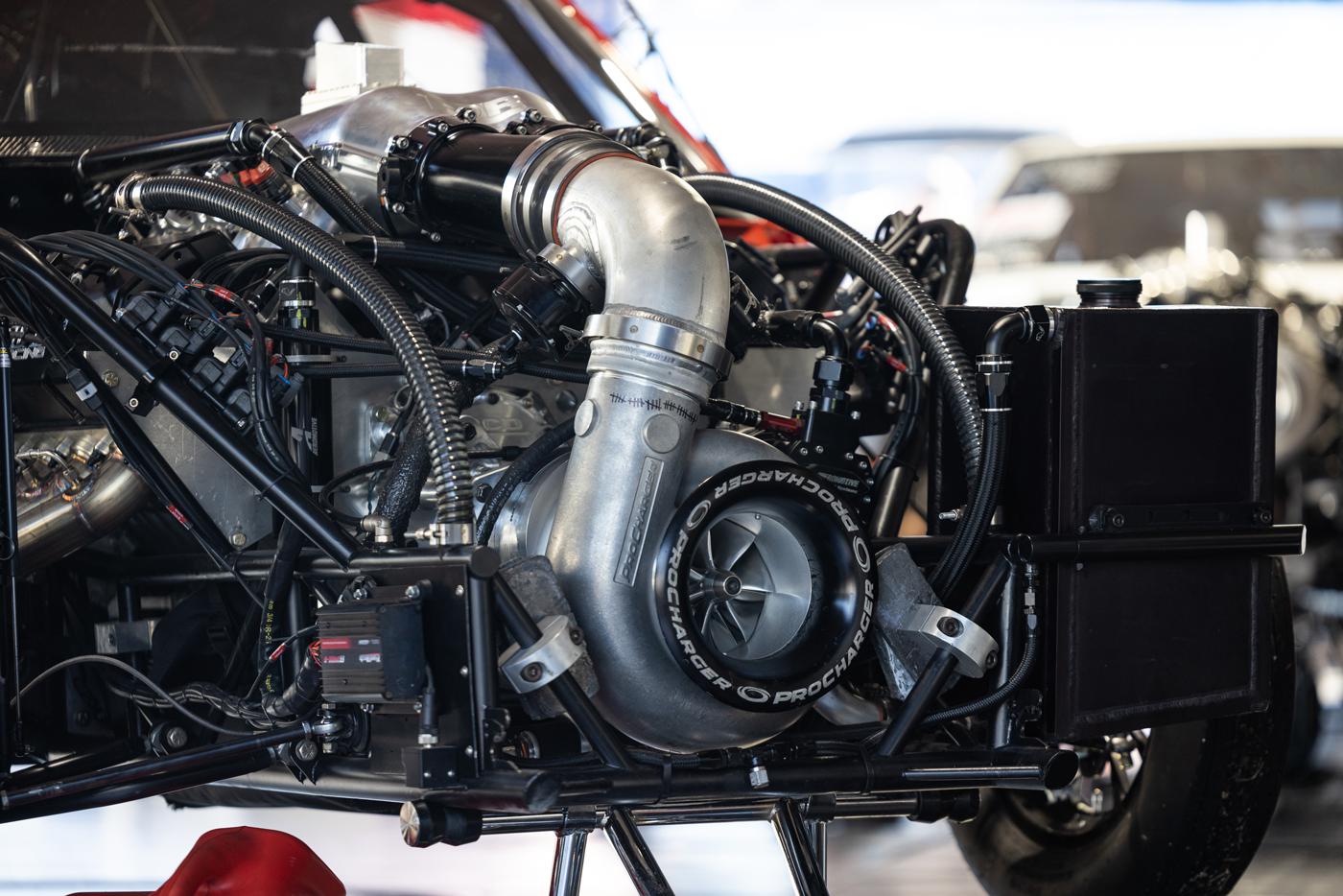
With recent advancements in design and production, superchargers are more capable and efficient than ever before. And while that’s allowed the horsepower potential to reach new heights, maximum output isn’t always the primary target.
Blowers have been an object of desire for speed freaks since the dawn of hot rodding, and roughly a century after the first supercharged automobiles started competing in organized motorsports, they’re still sought-after commodities today. It’s no secret that forced induction is the key to big horsepower numbers, and today’s supercharger designs offer capability that eclipses what was possible even just a few years ago.
“Right now, our largest impeller is 131 mm, and no one has maxed out the capability of that unit yet,” said Brian Cox of Vortech Engineering, Oxnard, California. “We’ve seen a few racers making as much as 3,600 horsepower at the wheels with it. But we know that they’ll find the ceiling soon enough, so we’re already working on the next iteration.”
These strides in supercharger performance come from a variety of different improvements in design, construction, and production, but each manufacturer has its own strategy for success. We spoke with some of the companies that are driving innovation in the segment to get a better sense of how they’re pushing the performance envelope today, and what they have planned for the future.
ProCharger
While improvements in simulation software have helped ProCharger of Lenexa, Kansas, in some aspects of design, Erik Radzins told us that data collection has been the real key to design improvements in recent years. “The computer programs help to point you in the right direction, so that saves some time, and it allows us to determine if a theoretical design is feasible—whether our machines can produce it or if they’re going to smash the bit halfway through the run,” he said. “But at the end of the day it’s real-world testing, working with engine builders, and sharing data that has really made the difference. Ten years ago, data sharing between companies was virtually non-existent. But these days everyone really wants to push the sport of drag racing forward, and the engine builders have realized that we’re not going to start building engines.”
Radzins said that most of ProCharger’s motorsports-spec blowers are designed independently from those intended for street applications and are largely built around sanctioning bodies’ class rule sets. That allows ProCharger to focus on refining specific elements of the blower to give racers the capability that they’re looking for. “We took a clean-sheet approach when designing the gearbox for the Pro Mod blower, the F4X,” he explained. “That blower makes so much horsepower, and those guys are running them so often that they needed a really, really durable gearbox.”
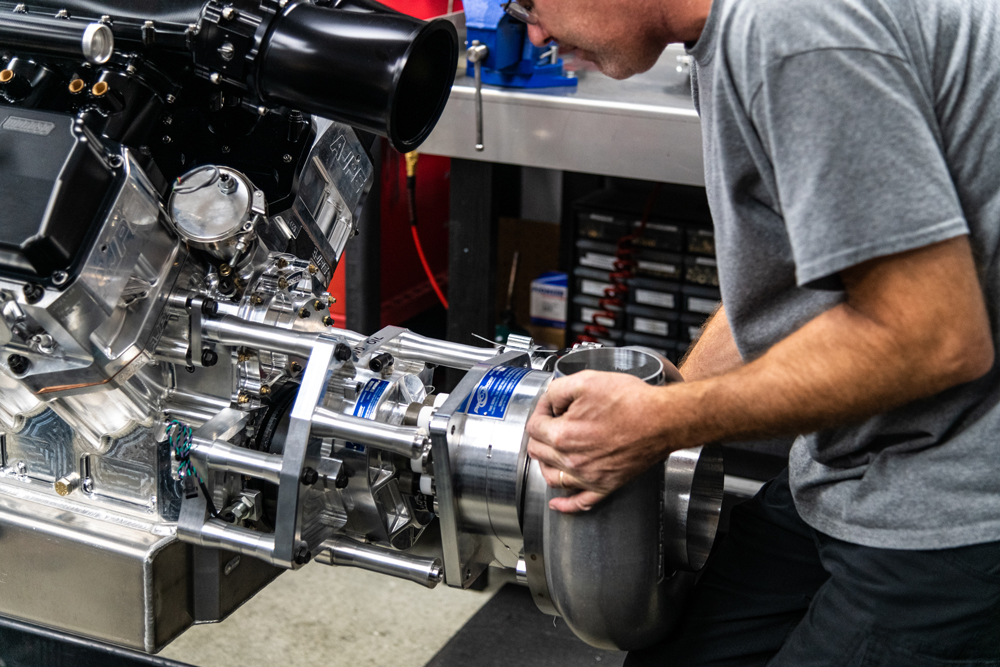
ProCharger’s Cliff Hall explained that, in the realm of motorsports, peak performance and durability tend to go hand-in-hand. “When someone comes to us and asks us to build a blower capable of more than 3,500 horsepower, it makes us go back to the design board on the gearbox side of things.”
A few years ago, ProCharger also introduced the CrankDrive gear-drive system for all of its F-series superchargers. “We took the same concepts we were using with our gearbox technology and applied that to the CrankDrive,” said Radzins. “When we went to design it, we listened to what the racers and the engine builders wanted out of it. The idea was to provide these racers with a better solution for a gear-drive system. They didn’t have to call anybody else, worry about delays or problems with someone else’s manufacturing tolerances, etc. They could just get the entire supercharger system that we designed and built as a holistic solution.”
Radzins said the company has also improved its machining tolerances in recent years. “Each race blower gets fully inspected by a coordinate measuring machine before it goes out the door, and if it doesn’t meet our production standards, it gets tossed in the trash.”
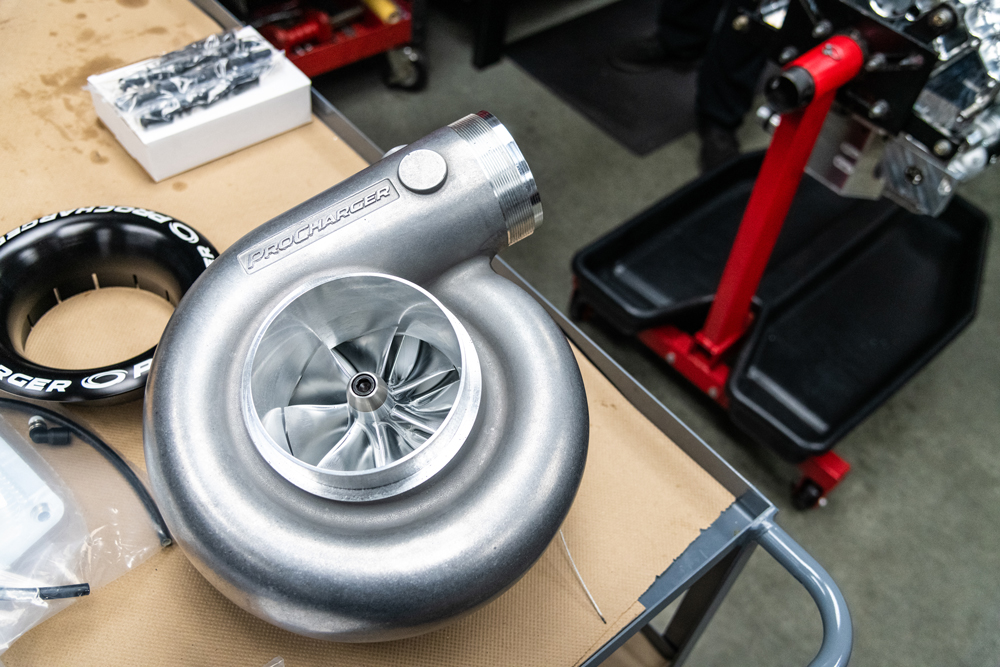
Part of the improvement comes from these strict quality assurance measures, but Radzins noted that the machining process itself has changed as well. “With a lot of our race products, the two halves of the blower case are made next to each other on the same machine on the same run, then they’re assembled and re-machined as a torqued assembly to ensure that everything is aligned perfectly.”
Going forward, Radzins said that ProCharger’s current focus is on fine-tuning and filling in the power level gaps where they exist in the company’s product portfolio rather than focusing on making as much horsepower as possible. “Nobody is calling us asking for 500 more horsepower at this stage, so there really isn’t a need for a bigger blower right now,” he explained. “A lot of folks realize that they don’t need 5,000 horsepower—especially in the no-prep scene. The track can’t hold it. Having a repeatable, durable, deadly consistent combination is more important.”
Whipple Superchargers
As automakers continue to dish out increasingly robust engine combinations and drivetrain components, the line between street and race applications is blurrier than ever. Those improvements at the OE level have allowed Whipple Superchargers in Fresno, California, to focus on making more power with less boost, an effort that Dustin Whipple said has been significantly aided by simulation software.
“The use of computational fluid dynamics (CFD) modeling has really helped things advance at a much faster rate than ever before,” Whipple explained. “Before CFD, making superchargers and testing them for different applications took forever, and it was extremely expensive. With the simulation work we do now, we can run multiple versions of a design idea simultaneously and determine which of those should move on to the prototyping phase. That was a significant shift in our approach to design, and it allowed us to take paths that we hadn’t taken before.”
Whipple’s earlier development efforts saw the manufacturer adapting products initially designed for street applications for use in motorsports, a strategy that was due in part to some of the race classes that the company was involved with at the time. These days it’s the other way around.
“The great thing about the racing side right now is that it’s going into uncharted territory,” Whipple said. “The Gen 5 was where we moved in a new direction, and now we have the Gen 5x, which was developed based around what we learned in competition. And then there’s the Gen 6 that’s on the way, which is also derived from the racing side.”
That motorsports-based development approach allowed Whipple to find ways to improve efficiencies across the board. “Compared to where we were five or seven years ago, we’re making more power with smaller superchargers,” Whipple said. “Back then we couldn’t spin the compressor at the levels we’re using today—efficiency fell off and the temperatures went off the charts. Back then we might’ve been able to reach some of the performance metrics we’re at today, but we would have had to make some sacrifices to get there. It is sort of like a turbo application: If you wanted to chase one part of the curve, you had to give up everything else. That’s not the case anymore. We don’t have to give up power down low to make power at the top.”
The aforementioned CFD work has played an important role in component design for Whipple as well. “Matching components in the inlet system, the discharge system, and the intercooler is definitely far more important now than ever before,” he said. “As the compressor flow went up, we had to make sure that the rest of the system was capable of handling that higher volume. And what works well for one application might not be ideal for another.”
While the Gen 5 unit introduced a brand new rotor design, and the Gen 5x ushered in new shaft and inlet designs—along with some changes to the intercooler and a number of smaller refinements—the Gen 6 showcases the next iteration of Whipple’s rotor design, which focuses on delivering more low-end torque as well as more power at the top end. “The gains are very noticeable, especially as the boost levels go up,” Whipple added. “Development never really stops. We’re constantly investigating new ideas and testing new things that can make the product better.”
Vortech Engineering
When it comes to developing superchargers for motorsports use, manufacturers are always on the lookout for upcoming rule set changes. When a sanctioning body decides to make a tweak, it sends companies like Vortech back to the design lab to see how they can meet that new criteria while providing competitors with the most capable design possible.
“We might have a blower out there with, say, a 123-mm inducer, and it’ll make a ton of power, but a sanctioning body might decide that they want to slow the class down,” said Cox. “They usually do that by changing the inducer size to limit the power that the blower can make. When that happens, you’re actually putting the blower in a bad spot—it’s really the wrong way to slow things down. But the motor’s already built, and a racer might have a hundred grand in that motor already. They’re looking for another, less costly way to slow it down, so we have to design around those circumstances. It’s something that supercharger companies spend a lot of time chasing.”
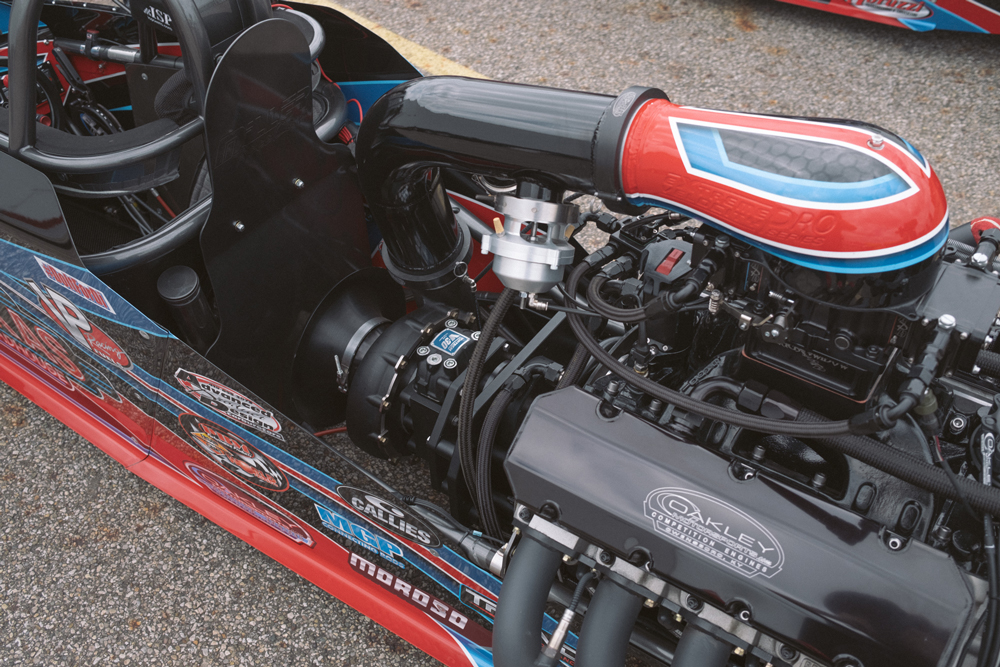
It’s another situation where software has become a crucial component of the design process, a tool that now allows Vortech to run extensive simulations and vet a number of potential solutions before the company ever builds any physical parts. “There are certain aspects of an impeller that you want to focus on—the rpm where it creates power, the efficiency of it, things like that,” he said. “All of that can now be calculated before a part is built.”
That, in turn, has helped to push supercharger design into truly purpose-built territory.
“For instance, we were working with a Pro Mod driver, and we were using our largest supercharger—the 131—but his motor was actually too large for it,” Cox recalled. “It was putting the blower in a bad spot, so we went back and made changes to the impeller to dial that system in for his combination. The software allows us to design for a boost number, or a pressure ratio, or a pound-per-minute measurement of how much air it needs to move. It allows us to design around the specifics of an engine combination.”
After finding the limits of conventional materials like 6061 and 7075 aluminum, the company also decided to move to a proprietary forging process to manufacture its impellers in order to address the high loads and temperatures they’re subjected to. Meanwhile, Vortech’s modular gear case design has allowed racers to alter the configuration in order to, for instance, make changes as needed based on two different sanctioning body rule sets.
Although the company is actively considering what competitors will be looking for down the road, Cox said that predicting exactly what form that will take can be tricky. “We’re making a ton of power now, but we have to anticipate what the next step for this racer is going to be. We’re doing that R&D now—the design stuff is on the table. But any time you make things larger you’re adding mass, so if you make a larger impeller, you lose the stiffness of the shaft and add extra loads when it’s spinning that fast. A lot of things need to be re-designed to make it work. So saying, ‘Yes, we do need a 150-mm inducer blower for the guy who needs 4,000 or 5,000 horsepower’ is a leap of faith, to a degree.”
Magnuson Superchargers
Racers are always on the lookout for the latest and greatest—the “best” option available. But in the realm of motorsports, that can be a moving target. “The reality is that every supercharger manufacturer has a criteria that they’re trying to achieve,” said Kim Pendergast of Magnuson Superchargers, Ventura, California. “Are you designing for quarter-mile drag racing, or an endurance format? Do you need torque, or do you need horsepower? Are you willing to risk a failure to get every last ounce of performance out of it? It all really comes down to what you’re trying to do with the supercharger.”
Over the past few years, Magnuson has sharpened its focus on its testing methods in order to find the balance between competitive performance and rock-solid reliability. “There are some customers who don’t really care about reliability—they just want power,” Pendergast said. “Sometimes that’s our blower, sometimes it’s not. Making a single supercharger with a lot more power is not very interesting to us. What is interesting to us is being able to replicate performance consistently. That’s hard to do at a price point that more than two people out there can afford.”
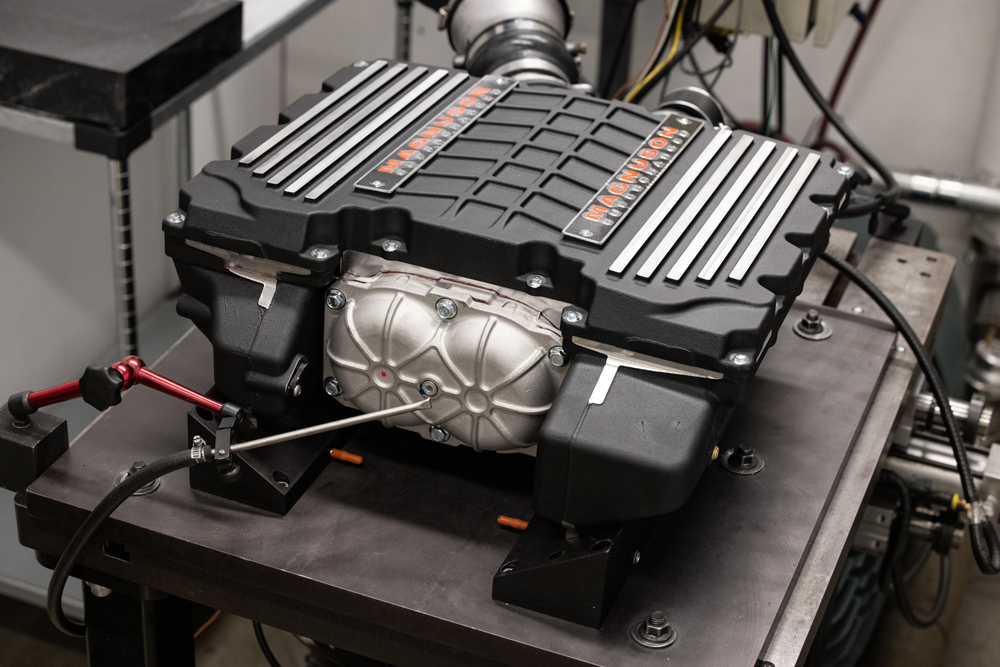
To help facilitate those efforts, Magnuson brought in testing equipment from Arrington Engines, a company that was building powerplants for NASCAR when Pendergast was at the helm. The idea was to find any potential weak links in the system, address them, and continue running the testing processes until the design was bulletproof.
“Bringing over the airflow bench allowed us to optimize parts, but optimizing a part doesn’t necessarily optimize it for the whole system,” she said. “The next step was to run the system with the intercooler cores on a supercharger test stand. To really properly test something like the TVS2650 it required a larger test stand, so we just finished building one to handle the higher horsepower. From there the system goes to an engine stand before it gets installed in a vehicle.” Once a design has been given the nod, Magnuson puts that system through the ringer by handing it over to engine manufacturers that are supplying racers in order to get additional feedback from the race track.
Pendergast likens Magnuson’s old design approach to a Lego set—a modular solution that allowed one template to be easily adapted to a number of different vehicles. These days it’s more about an integrated design that tailors the system more specifically to the requirements of the platform. “Some of it is because of packaging, but it also just allows you to produce a better system overall. It gives you more flexibility to achieve the targets that are set for a given application.”
Changes in the company’s design philosophy also led Magnuson to broaden its supplier network, a move that allowed it to implement a patented porting technique to squeeze more efficiency out of its systems.
Looking ahead, Pendergast said that folks should expect to see a stronger presence from Magnuson in the Mopar world over the next few years, along with larger supercharger options aimed at the high end of the market.
Sources
Magnuson Superchargers
magnusonsuperchargers.com
ProCharger
procharger.com
Vortech Engineering
vortechsuperchargers.com
Whipple Superchargers
whipplesuperchargers.com
 MEMBERSHIP LOGIN
MEMBERSHIP LOGIN JOIN PRI
JOIN PRI




